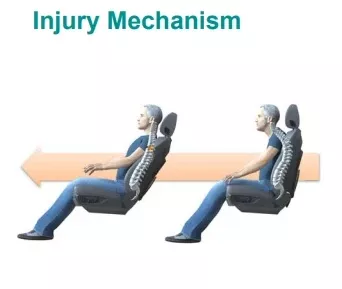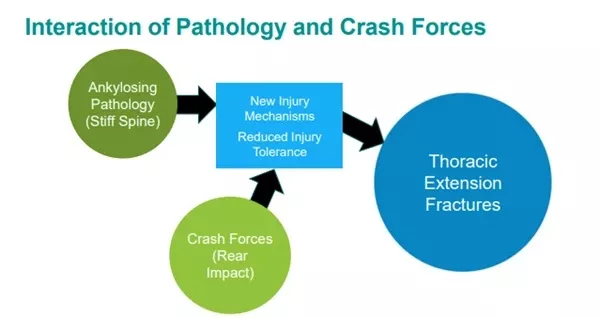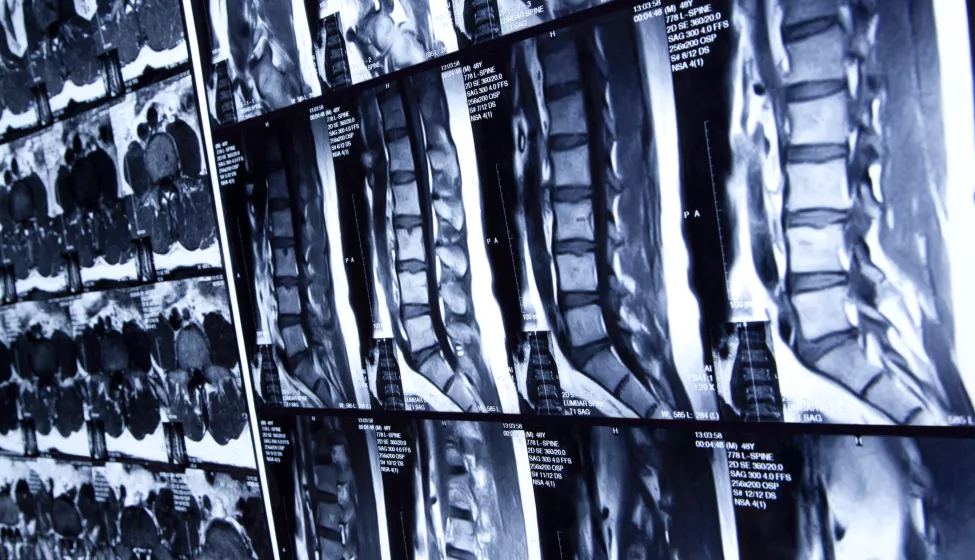June 19, 2021
When attorneys are faced with product liability cases involving rear-end motor vehicle crashes, spinal disease may not be their first thought — but maybe it should be. When spinal disease or degeneration renders a spine stiff (ankylosed), extremely curved (hyperkyphotic), or brittle (osteopenic or osteoporotic), the spine is more susceptible to injury even from minor trauma. This explains how occupants with spinal disease can incur disabling spinal cord injuries in rear-end motor vehicle crashes even at low to moderate speeds.
Over the past decade, our team at Exponent has seen an increasing number of vehicle occupants sustain spinal fractures and serious spinal cord injury in rear-end crashes that end up in litigation.
In many of these cases, the injuries can be explained by a combination of impact energy and spinal pathology.
As the U.S. population continues to age and spinal disease becomes more prevalent, it will be increasingly important for attorneys and other stakeholders in product liability cases to analyze injury mechanisms at the intersection of chronic spinal pathology and crash forces. Understanding how spine health and seat yielding contribute to rear-crash safety can help attorneys clarify the complex circumstances surrounding rear-crash spinal cord injuries.
How Pre-existing Spinal Pathology Can Contribute to Serious Rear-Crash Injuries
Ankylosing spondylitis (AS), diffuse idiopathic skeletal hyperostosis (DISH), and other degenerative conditions can stiffen spinal joints, embrittle spinal bones, and bend the thoracic spine into exaggerated kyphosis. AS and DISH are both widely associated with fractures from minor trauma.
In a rear motor vehicle impact, crash forces straighten the occupant's back along the seatback. Unfortunately, the stiffer spines of occupants with spine disease are less flexible under these forces. When a stiff, brittle, kyphotic spine is suddenly accelerated, the unsupported mass creates an extension moment, the kyphosis is forcibly straightened, and the embrittled bones may fracture.
Excessive bone growth in spinal degenerative disease can also cause stenosis, or narrowing of the spinal canal. Stenosis is associated with greater risk of spinal cord injury with or without fracture during spinal extension in a rear impact. This is how occupants with spinal disease can incur serious cervical or thoracic spine injuries even when rear vehicle crashes occur at low to moderate speeds.
Figure 1

Figure 2

The Importance of Yielding Seats
Some experts argue that vehicle manufacturers could limit certain injury mechanisms in high-speed rear impacts by making seats more rigid. However, severe reductions in seat yielding could increase injury risks in more field-relevant conditions. This phenomenon is well established vis-à-vis neck loads where studies show extremely rigid seats can increase lower neck extension moments to levels corresponding with risk of injury.
Similarly, making seats extremely rigid could increase loading in the spine and create risk of serious injury for those with spinal pathologies like AS and DISH. From a design perspective, seats that yield in a controlled manner while maximally supporting the spine and head provide the best circumstances for occupants with spinal pathologies. Yielding seat properties absorb energy and lower the forces applied to the spine in rear crashes, especially the forces that tend to straighten a kyphotic spine against the seatback.
Because seats also need to be strong enough to support and retain an occupant, seat manufacturers have to strike a balance between good occupant retention and good energy absorption in field-relevant conditions. Modern automotive seats tend to do this well. Even though modern seats are stronger than seats from prior eras, they also yield to manage crash forces and keep occupants safe in the vast majority of crashes.
In our experience, rear-crash cases involving serious spinal cord injuries today increasingly involve occupants with spinal pathologies who are especially in need of seats that yield under occupant loading in rear impacts to reduce forces on the spine. Unfortunately, as the U.S. population ages, and older adults keep their driver's licenses longer, we may be seeing more of these injuries in the field.
How Exponent Can Help
Exponent's multi-disciplinary team of epidemiologists, biomechanical engineers, automotive engineers, pathologists, radiologists, and regulatory experts has the experience, knowledge, and technology needed to identify degenerative spine pathologies and quantify their effects on biomechanical responses and crash injuries. We can help seat and vehicle manufacturers conduct safety benefit analyses, perform crash and sled tests, analyze injury mechanisms, and create demonstrative graphics to communicate our findings to a wide variety of audiences.

